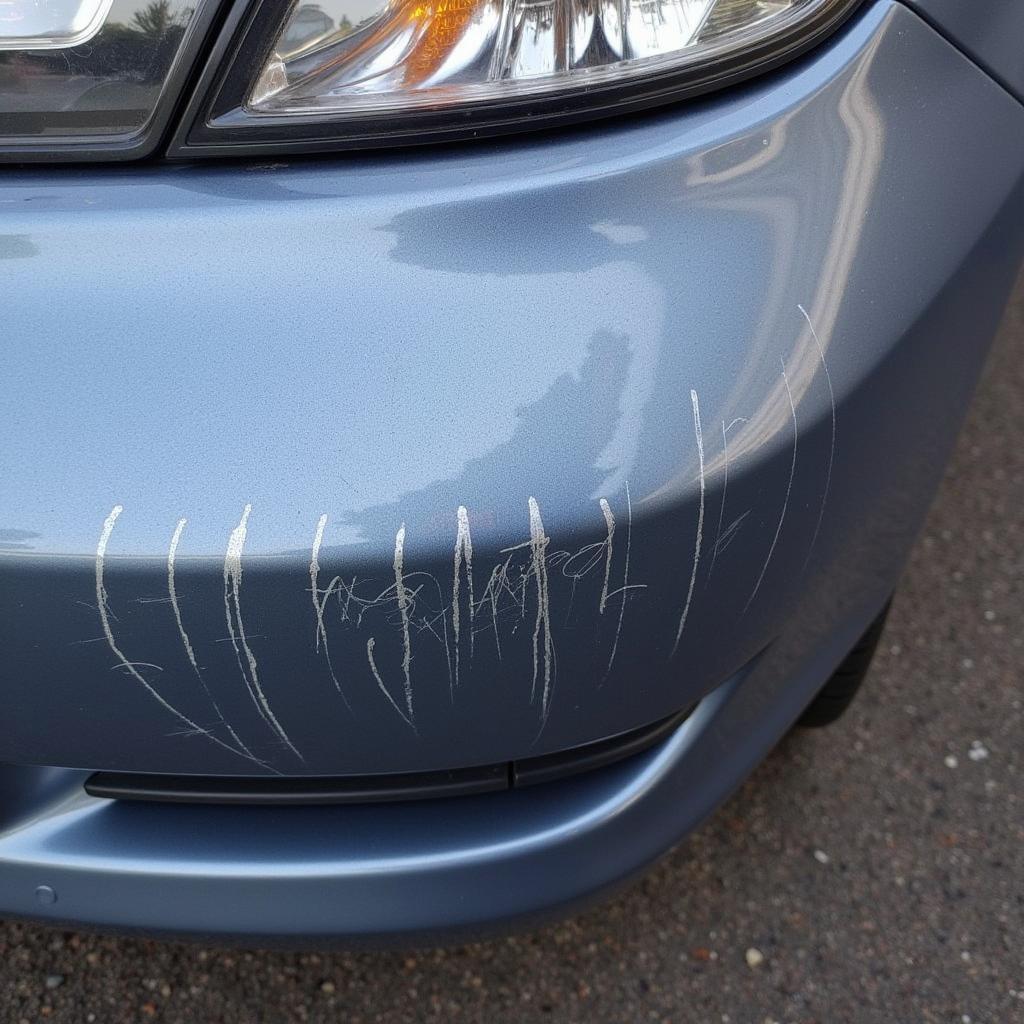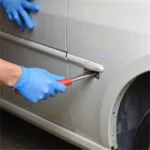Fixing those unsightly scratches on your car bumper doesn’t always require a trip to the auto shop. With a little time and the right approach, you can often repair minor to moderate scratches yourself and save a significant amount of money. This guide will walk you through the steps on how to repair scratches on the bumper of your car, providing you with the knowledge to restore your car’s appearance with confidence.
Assessing the Damage: What Type of Scratch Is It?
Before you begin, it’s crucial to determine the severity of the scratch on your car bumper.
- Clearcoat Scratches: These are the most superficial scratches, only affecting the clear coat layer of your car’s paint. They often appear white or lighter than your car’s paint.
- Paint Scratches: These scratches go deeper than the clear coat, cutting into the colored paint layer. You’ll see the actual color of your car’s paint missing.
- Deep Gouges: These are the most severe, penetrating through the paint and primer, exposing the bare plastic bumper underneath.
Knowing the type of scratch you’re dealing with will help you determine the appropriate repair method and the necessary products.
DIY Repair for Light Scratches
For light clearcoat scratches and minor paint scratches, you can often restore your bumper’s appearance using DIY methods:
- Clean the Area: Wash and dry the scratched area thoroughly with car wash soap and water.
- Rubbing Compound: Apply a small amount of rubbing compound to a clean microfiber cloth. Gently rub the compound onto the scratch using circular motions. This process polishes away a thin layer of clear coat, smoothing out the scratch.
- Polish: After removing the scratch with the rubbing compound, apply car polish to the area using a clean microfiber cloth. This step restores shine and protects the newly exposed clear coat.
how to repair scratches on car bumper
Repairing Deeper Scratches and Gouges
Deeper scratches and gouges require a more involved approach:
- Clean and Sand: Clean the area with soap and water. If the gouge is deep, use fine-grit sandpaper (around 2000-grit) to smooth the edges.
- Apply Primer (If Necessary): If the plastic bumper is exposed, apply a thin coat of plastic primer to the area and let it dry. Primer ensures proper paint adhesion.
- Touch-Up Paint: Choose touch-up paint that matches your car’s color code (found in your owner’s manual or on a sticker inside the driver’s side door jamb). Apply thin coats of paint to the scratched area, allowing each coat to dry before applying the next.
- Clear Coat: Once the touch-up paint is dry, apply a clear coat to seal and protect the paint.
- Sanding and Polishing: After the clear coat has cured (usually 24-48 hours), use fine-grit sandpaper (2000-grit or higher) to level the area. Follow with polishing compound and car polish to blend the repair and restore shine.
“When dealing with deep scratches, patience is key,” says John Davis, an experienced auto body technician at CarCare Mechanics. “Take your time with each step, from sanding to applying touch-up paint and clear coat, to achieve a professional-looking result.”
Bumper Repair Kits: A Convenient Solution
Car bumper repair kits offer a convenient and all-in-one solution for addressing scratches and gouges. These kits typically include:
- Cleaning solution
- Sandpaper
- Primer
- Touch-up paint
- Clear coat
- Applicators
[how to repair scratches on car plastic bumper](https://carrepairon.com/how to-repair-scratches-on-car-plastic-bumper/)
Dealing with Black Plastic Bumpers
how to repair scratches on black plastic car bumper
Scratches on black plastic bumpers can be particularly noticeable. Specialized black plastic bumper restorers are available to address these:
- Clean the Area: Thoroughly clean the scratched area with soap and water.
- Apply Restorer: Apply the black plastic bumper restorer according to the product instructions. Many products come with an applicator pad for easy use.
- Buff to a Shine: Once the restorer has cured, buff the area with a clean microfiber cloth to enhance the shine.
“Black plastic bumper restorers not only mask scratches but also revitalize the faded appearance of older bumpers, making them look new again,” says Maria Sanchez, a veteran automotive detailer with over 20 years of experience.
Conclusion
Repairing scratches on your car bumper can seem daunting, but with the right guidance and a little effort, you can achieve impressive results yourself. Remember to assess the severity of the damage to determine the most appropriate repair method. For deeper scratches and gouges, patience and attention to detail are essential for a seamless finish. If you’re unsure about tackling the repair yourself, seeking professional help from an auto body shop is always a viable option. By following the steps outlined in this guide, you’ll be well-equipped to tackle those unsightly scratches and restore your car bumper to its former glory.


